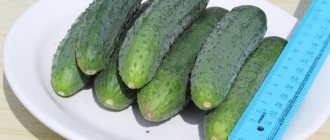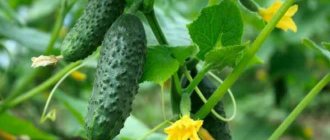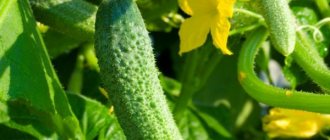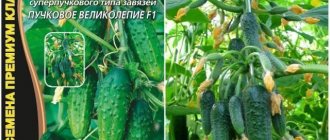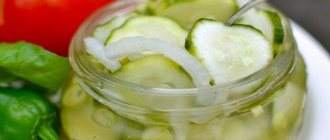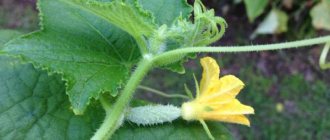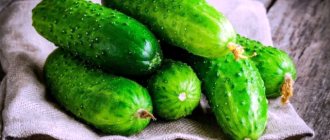Description of cucumbers Emerald Stream
The Emerald Stream variety was bred by agricultural specialists. The variety was included in the State Register of the Russian Federation in 2007. When working on the Emerald Stream hybrid, the varieties of Chinese cucumbers, which are known for their uneven fruiting and remarkable appearance, were taken as a basis.
A special feature of the Emerald Stream variety is its frost resistance: cucumbers are recommended for planting in all regions of the country.
Description of the appearance of Emerald Stream cucumbers:
- The cucumber bush is tall, dense with an average degree of branching;
- leaves are light green, rough, tightly attached to the stem;
- The fruits of the variety are long, can grow up to 25 cm, the skin is medium thick, without bitterness, dark green in color.
The weight of the fruit can reach 200 g. The peel is covered with small prickly spines with a soft edge. The length of the fruit makes the Emerald Stream variety similar to Chinese varieties, which usually grow to 20 - 30 cm.
Harvesting and application
Harvest when the cucumbers reach a length of 18-25 cm. Overgrown fruits, more than 45 cm long, become coarse and yellow, which leads to a deterioration in taste. Harvesting takes place every day or every other day. The harvest is stored in a cool, ventilated room. The temperature in the room for storing greenhouse cucumbers should not exceed +14°C, for cucumbers from open ground +9°C.
Important : Do not tear, but carefully cut off ripe fruits so as not to damage the ovary.
Reviews indicate that the taste characteristics of the hybrid are at a high level. First of all, the Emerald Stream hybrid was created as a salad cucumber, so it is best to use it fresh. Due to their size, the fruits are not suitable for whole-fruit canning.
Pros and cons of Emerald Stream cucumbers
The Emerald Stream variety has mainly positive characteristics. Its main advantages include the following parameters:
- early ripeness (fruits are harvested on the 40th - 45th day after emergence);
- stable and long-term fruiting (cucumbers are harvested throughout the summer);
- the crop can be grown in open ground and in greenhouses;
- resistance to fungal infections;
- grow in the shade, can withstand frost with additional shelter;
- resistant to aphids and mites.
The Emerald Stream variety is classified as parthenocarpic varieties, that is, the plant does not require pollination by insects, although, according to breeders, pollination increases productivity.
The disadvantage of cucumbers is that they belong to the salad type, but summer residents believe that the fruits are suitable for pickling. The only difficulty is the size of the fruit. Long cucumbers are inconvenient to place in containers usual for pickling and pickling.
Description of the hybrid
In 2007, the Emerald Stream cucumber appeared in the State Register of Plants of the Russian Federation in all regions, which fully lives up to its name due to its abundant, long-term fruiting. Bred by breeders of the Moscow agricultural company Sedek. Its authors are Dubinina I.N., Dubinin S.V. and Lukyanenko A.N.
The hybrid is early ripening, so the first harvest can be harvested 44-48 days after emergence. Let us consider separately what characterizes the bushes and fruits of the plant.
Bushes
The plant is parthenocarpic (self-pollinating), which makes the hybrid universal, since it produces equally good yields both under film covers and in open ground. Moreover, it is suitable for both spring-summer and summer-autumn rotation.
As for the other characteristics of the plant, they are as follows:
- bushes are powerful, medium-sized and medium-climbing;
- stems are strong;
- the leaves are dark green and relatively large;
- ovaries are abundant and bunch-shaped;
- lateral shoots with good regrowth;
- the type of flowering is predominantly female (only female flowers appear in the axils).
It should be borne in mind that a vigorous plant needs stable support. So, the bushes should be tied up using a net or trellis. In addition, pinching side shoots will stimulate the formation of new ovaries.
With proper care, each bush can be filled with 4-5 vegetables at the same time.
Fruit
Representatives of this cucumber crop are often called giants, since their length can reach up to half a meter and their weight can reach 250-300 g. About 1.5 months pass from the moment of planting to the appearance of the first cucumbers suitable for fresh consumption. Their exact characteristics look like this:
- Form . Elongated-cylindrical, often curved, with weak ribbing, medium tuberosity and a long handle (neck).
- Dimensions . On average, the length of the fruit is 30-50 cm, and the weight is 150-200 g.
- Peel . Soft, thin and dark green with small whitish stripes, medium density pubescence, spiny and white spines.
- Pulp . Crispy, with a small seed chamber and small seeds, a pronounced cucumber aroma and an excellent sweet taste, without bitterness.
The most delicious are cucumbers that reach no more than 25 cm in length. Such specimens are the most tender, sweet and crunchy. It is undesirable to allow them to grow beyond 45-50 cm, since in this case they will lose their taste and may thicken, crack and turn yellow.
You can see what ripe fruits look like in the video below:
Characteristics table
More details about the main qualities of the hybrid can be found below:
| Parameter | Description |
| general description | An early ripening hybrid that produces the first harvest 44-48 days after sowing the seeds. |
| Growing conditions | It can be cultivated throughout the country, growing in open beds, in protected ground, under temporary film cover. The hybrid is cold-resistant, shade-tolerant and drought-resistant, therefore it can withstand adverse weather conditions and adapt to temperature changes. You just need to take into account that the plant is tall and powerful, so it requires a lot of space to grow. |
| Productivity | Subject to compliance with agricultural technology from 1 sq. m of bed, you can collect on average 5-7 kg of greens. It is noteworthy that the hybrid bears fruit throughout the season, right up to the first frost and snow, forming new fruits after ripe cucumbers are removed from the vines. |
| Resistance to diseases and pests | Hydride has strong immunity to many diseases that pose a danger to cucumbers. So, it rarely gets sick with powdery mildew, cladosporiosis, etc. In addition, the plant is rarely attacked by spider mites and aphids. However, it can suffer from root rot. |
| Purpose | Emerald Stream is a salad hybrid, so it is best used fresh and for making salads. Less commonly, thin fruits are used lightly salted, salted and pickled. They are large in size, so they have to be cut into several pieces to fit into the jars. |
The characteristics of the Emerald Stream and the method of growing it are described in the following video:
Optimal growing conditions
Emerald Stream cucumbers are grown in seedlings. Emerald Stream cucumber seedlings take root in the house, then they are planted in a greenhouse or on a plot of open ground.
For full growth, cucumbers need to maintain temperature conditions. This concerns soil warming. So, cucumbers are not planted unless the soil warms up to at least +15 °C.
For cucumbers, choose areas that are illuminated by the sun in the morning and afternoon. They should be removed from places where through winds occur.
To prevent the vines from spreading along the ground, trellis supports or additional supports are used to grow them. The lashes are tied up as needed. The fruits are collected in a timely manner so that the plant has the opportunity to form new ones.
How to grow your own
The hybrid Emerald Stream is universal in cultivation and is suitable for planting in open ground, under film covers, in greenhouses and even at home. Let's consider two main methods of planting: seed and seedlings.
Planting by seeds and seedlings
Vegetable growers recommend growing the Emerald Stream hybrid using seedlings. But no matter which method you choose, the soil on the site must be loosened and saturated with nutrients. For better development of cucumbers, add potash, nitrogen and phosphorus fertilizers.
Attention : Fertilizers are applied to the land plot for future cucumbers in the fall. Clear the soil well of weeds and residues of other plants, apply any organic fertilizer. Then dig again. If it was not possible to feed the soil in the fall, do it in the spring.
Seeds are planted in open ground after night frosts have passed, so that the soil has time to warm up to +15-18°C. Planting seeds in open ground is considered the most relevant method for the southern regions of Russia.
Seed planting process:
- Loosen the soil before planting seeds.
- Plant no more than four plants per square meter.
- Make holes in the ground 3 cm deep and put seeds in them, 2-3 pieces will be enough. If all the seedlings sprout, they are thinned out.
The seedling method is suitable for those who want to get a tasty harvest at the beginning of summer. Seeds for seedlings are sown in early March.
- Plant the seeds in peat or individual plastic cups filled with ready-made soil.
- Lightly sprinkle soil on top and then water.
- Before the first sprouts appear, the cups are covered with film and placed in a warm place.
- When the soil warms up to +12°C and the average daily air temperature reaches +15°C, young plants are planted in open ground. By this time, they have 3-4 true leaves.
- Seedling planting pattern – 50x30 cm.
Attention : To make the seeds grow and develop faster, before planting, treat them with a solution of potassium permanganate, and then dry thoroughly.
Growing in stages and care
Emerald Stream cucumbers require regular and abundant watering with settled, warm water.
Important : It is recommended to water cucumbers in the morning or evening.
Plants need feeding throughout the growing season. Experts recommend using slurry, humus mixtures, urea solution and superphosphates as fertilizers.
Don’t forget to take care: regularly weed the beds, get rid of weeds and clean the area - cucumbers love cleanliness more than other vegetable crops.
Features of cultivation and possible difficulties
The emerald stream is tied to vertical trellises and plants are formed. The central stem of the cucumber is pinched as soon as it reaches the top of the trellis.
Diseases and pests
Emerald Stream is highly resistant to cladosporiosis and downy mildew. The hybrid is occasionally attacked by aphids or spider mites. They are fought with folk remedies (onion or garlic tinctures) or with the help of special insecticides according to the instructions.
Emerald is then susceptible to a disease such as root rot. To avoid infection, follow watering recommendations and avoid over-wetting the soil.
Growing cucumbers Emerald Stream
Planning for planting cucumbers begins with selecting a variety. If the Emerald Stream is suitable for planting on a summer cottage or personal plot, then the end of March - beginning of April is chosen for sowing.
Planting seedlings
Seeds are purchased in stores, then stage-by-stage processing begins.
- Calibration This is a method that allows you to select strong planting material. One tsp. salts are dissolved in a glass of warm water. The seeds are poured into the liquid. Empty shells float to the surface, the rest settle to the bottom.
- Germination. Place the seeds on a damp cloth and cover with a second strip of damp cloth. The saucer with the material is left on the windowsill at a temperature of at least +25 °C. After 12 hours, the seeds are washed with warm water.
- Soak. Before planting, the seeds need additional soaking. This event helps to activate internal capabilities. After soaking, the seeds are buried in the soil.
Soil for cucumbers is selected taking into account the fact that it should be light and nutritious. The soil should contain: peat, wood ash, and a small amount of additional minerals.
The prepared soil is disinfected with a weak solution of manganese, then a depression is made using a wooden stick. The seeds are buried one at a time no more than 2.5 cm, covered with soil, slammed down, and the surface of the soil is sprayed with water.
Information! Cucumbers are planted in separate containers due to the fact that they do not tolerate picking.
For planting, use plastic cups, cardboard boxes or peat pots.
Containers with plantings are covered with plastic film. From this moment, cucumbers begin to sprout in mini-greenhouses. For more effective germination, it is necessary to maintain temperature conditions. Seedlings require a temperature of +22 °C. Condensation that forms on the film is wiped off periodically. The soil surface is wetted from a sprayer.
In addition, plantings require periodic ventilation. To do this, remove the film for 1 - 2 hours a day.
Emerald Stream cucumbers sprout on the 4th - 6th day. During this period, they are left on the windowsill, where daylight lasts 10 - 12 hours.
After emergence of seedlings, the air temperature can be reduced by 2 - 4 °C. This happens on its own after removing the additional coating.
Landing in the ground
When planning the planting of seedlings, we focus on the following factors:
- the soil should be warmed up to +10 - +15 °C;
- the air temperature should be warmed up to +18 °C;
- on the shoots there are 3 - 4 leaves.
When planting in a greenhouse, the timing may be shifted. It depends on whether the room is heated and whether it is possible to ventilate there.
Advice! The formation of high ridges is suitable for greenhouse cultivation. This protects the plantings from freezing of the soil when frost occurs.
Seedlings are planted according to a certain pattern. For ease of manipulation, pull the cord between two pegs. Seating is arranged in rows along it. Make a distance of 30 - 35 cm between specimens. Emerald Stream cucumbers are not prone to growing, so in special cases you can reduce the distance to 25 cm.
The holes are prepared in advance; their size should approximately correspond to the size of the earthen ball with the root system of the seedling.
The shoots are placed in the holes using the transfer method. The hole is filled with soil and the surface is leveled. Then the plantings are watered.
Many summer residents mulch the soil after planting to prevent drying out or excessive moisture of the soil. For mulching, pine needles and peat are used.
Watering and fertilizing
At the first stage, when the seedlings take root, the cucumbers are watered weekly. As the vine grows and develops, watering is reduced. Basic rules of watering:
- exclude watering with strong pressure so as not to wash out the hole;
- watering from a watering can or hose with a special nozzle is suitable;
- the water should be warm and settled;
- The evening is chosen for the event to prevent direct sunlight from falling on the leaves after watering.
It is customary to feed Emerald Stream cucumbers 3 times:
- after the formation of the first leaf in a new place;
- on the 22nd day after seating;
- after the lashes close in the garden bed.
Mandatory fertilizing includes the application of organic fertilizers.
In addition, there are optional feedings that are carried out as needed. In this case, gardeners recommend focusing on the appearance of the plants.
| Browning of leaves, drying out of tips of leaf blades | Mineral fertilizers: potassium and phosphorus. |
| When leaves wither, fruits decrease, cucumbers change in size | Nitrogen-containing complexes. |
| When insect parasites appear | Processing with special means. |
Formation
To obtain a stable harvest of cucumbers, it is necessary to control the formation of ovaries and purposefully form lashes. Emerald Stream cucumbers are a tall variety, so additional supports are installed for their cultivation. To avoid problems, the formation of bushes begins from the moment of planting.
To ensure that the Emerald Stream variety can bear fruit stably, the bush is formed into 1 stem. This is achieved by observing the following points:
- when the 6th leaf appears, carefully remove all ovaries and stepsons that are formed in the axils of the leaves;
- later they begin to leave one ovary at a time, removing all the others.
Due to the fact that the Emerald Flow variety is a parthenocarpic species, the removal of stepsons must be carried out weekly.
Wooden trellises are suitable for supporting cucumbers. They are installed immediately after planting seedlings in order to place lashes on them in a timely manner. As they grow, the bushes are lifted and tied with nylon ropes.
Protection from diseases and pests
The cucumber variety Emerald Stream is considered resistant to infections and insect attacks. To increase the protective forces, the bushes are fed in a timely manner; to prevent the occurrence of infections, additional measures are taken, which include:
- processing of cucumber lashes;
- compliance with crop rotation;
- planting suitable neighboring crops.
Cucumbers are sprayed with a self-prepared solution, which helps strengthen the plant’s defenses. For 10 liters of water take 30 drops of iodine and 1 tbsp. l. hydrogen peroxide. This solution is sprayed onto the leaves from a distance of about 20 cm.
When planting, it should be taken into account that cucumbers are not planted after zucchini, pumpkin, squash, and carrots.
To repel insects, marigolds and calendula are planted next to cucumber beds.
Information! Do not plant strong-smelling herbs nearby.
Diseases and pests
This type of cucumber is disease-resistant, so it is not attacked by pests and does not get sick.
Experienced gardeners carry out preventive manipulations:
- observe the watering regime;
- spray the foliage with a weak solution of iodine and hydrogen peroxide;
- inspect stems and foliage, removing damaged ones;
- vegetables are planted together with calendula and marigolds; these flowers repel pests and insects.
These manipulations strengthen the flower’s immunity and make it stronger.
Growing and care
Cultivation in a permanent place is carried out taking into account the following features:
- The formation is carried out into 1 stem, the top of which is pinched at the level of the upper edge of the trellis.
- Fertilize the bushes regularly once every 10-14 days, add organic matter and minerals. The last feeding is needed 2 weeks before harvesting the greens.
- The beds are loosened to a depth of 3 cm, trying not to touch the surface roots.
- Water in the evenings with settled water and make sure that drops do not fall on the leaves.
Advantages and disadvantages of the variety
To briefly summarize the above, the advantages of the variety include:
- high productivity;
- good taste of ripe fruits;
- high resistance to powdery mildew;
- the crop tolerates transportation well over long distances;
- resistant to many pests;
- does not require pollination, so it can be grown on a loggia or balcony;
- early ripening of the crop.
Of the negative aspects of the hybrid, it should be noted:
- the variety may be affected by root rot;
- bushes require garters to trellises or mesh;
- unsuitable for canning.


